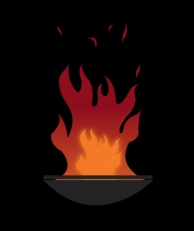ARE THE FIRES OF HELL A–GLOWING..? WAVEFORMS & ANIMATING FLAMES
by whiterabbitanimation
Hell would not be Hell without a flaming inferno and therefore animating fire became an important skill to master. My first attempt to animate flames wasn’t so successful as it didn’t convey an authentic movement (which, although not prerequisite for representing fire, seemed like a useful convention to learn.) The convention for animating fire is to treat it as a waveform that moves in a regenerative cyclical motion. Rather like a flag, water or any other material, the movement of flames is governed by the air currents that move through them.
Air rises from the hottest part of the fire (the centre) and is replaced by cool air rushing in from the sides at the base. This cooler air is subsequently heated by the fire and rises, sucking in more cooler air in its wake and resulting in a continuous process. The timing of the movement is fastest at the base, slowing as the air cools down on its journey through the fire. The movement of the flames is rapid, fluid and ever-changing, seemingly always rising upward. Any downward movement tends to ruin the effect. A good source of information on animating waveforms is “Timing For Animation” by Harold Whitaker and John Halas (Focal Press, 1981).
My initial attempt can be seen here. By comparison, my revised line test showing the air flow points can be seen here and the final inked version can be seen here.
